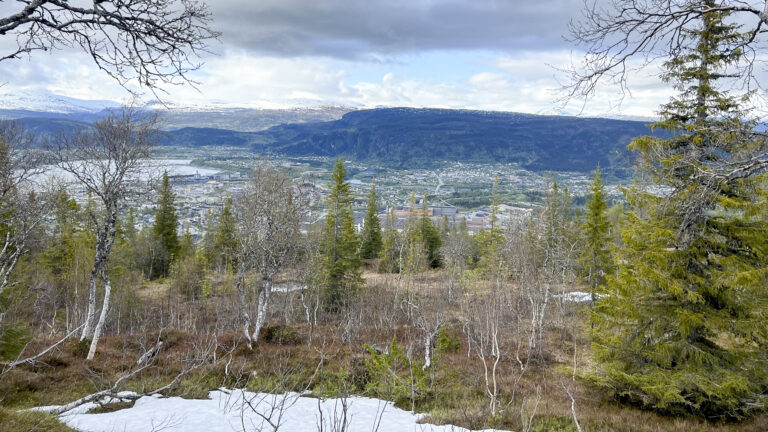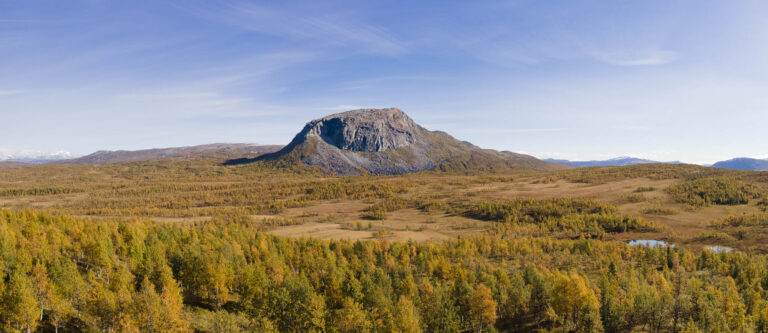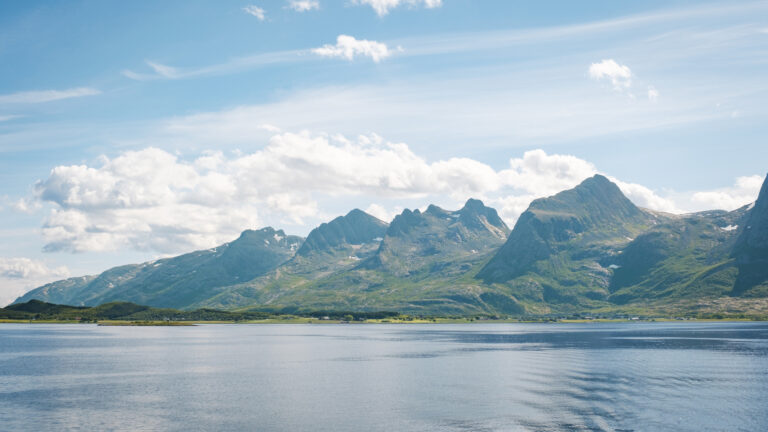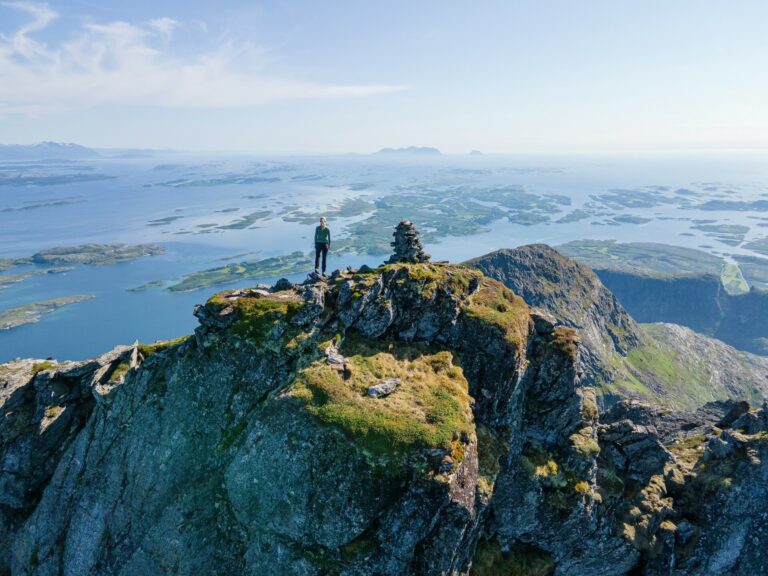A hiking adventure: The seven sisters - all seven peaks all at once
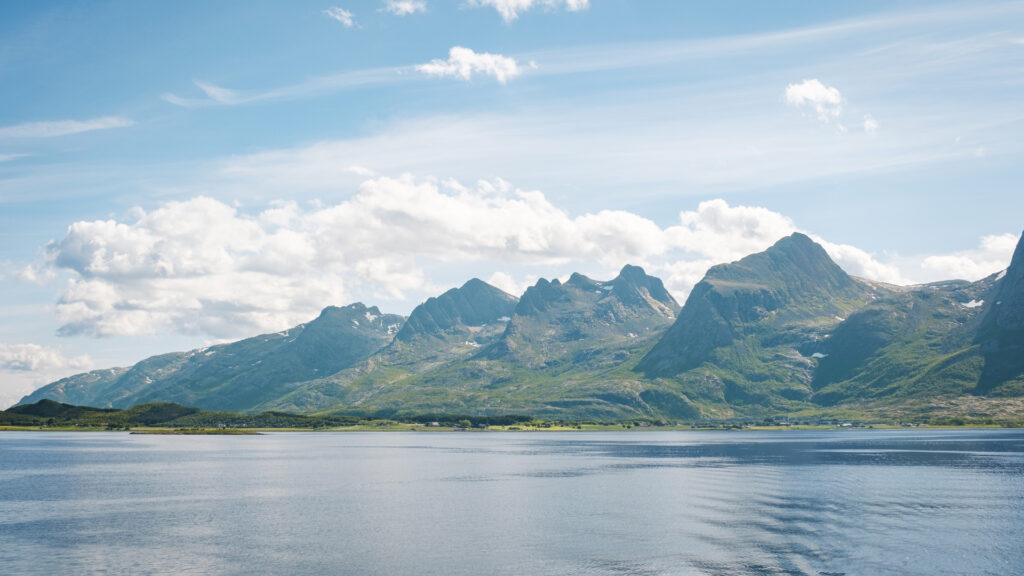 Kristoffer Møllevik / Visit Helgeland
Kristoffer Møllevik / Visit HelgelandTaking on all seven peaks of the Seven Sisters in a single hike is one of the toughest and most demanding mountain adventures in Helgeland. It’s a hike that requires good preparation and fitness — and it promises a nature experience you won’t forget.
Key info
Difficulty: Very demanding
Distance: 24–27 km
Elevation gain: 2,500–3,000 metres
Duration: 12–20 hours
Season: June – October
Starting point: Southernmost parking area for the Seven Sisters
View starting point on Google Maps
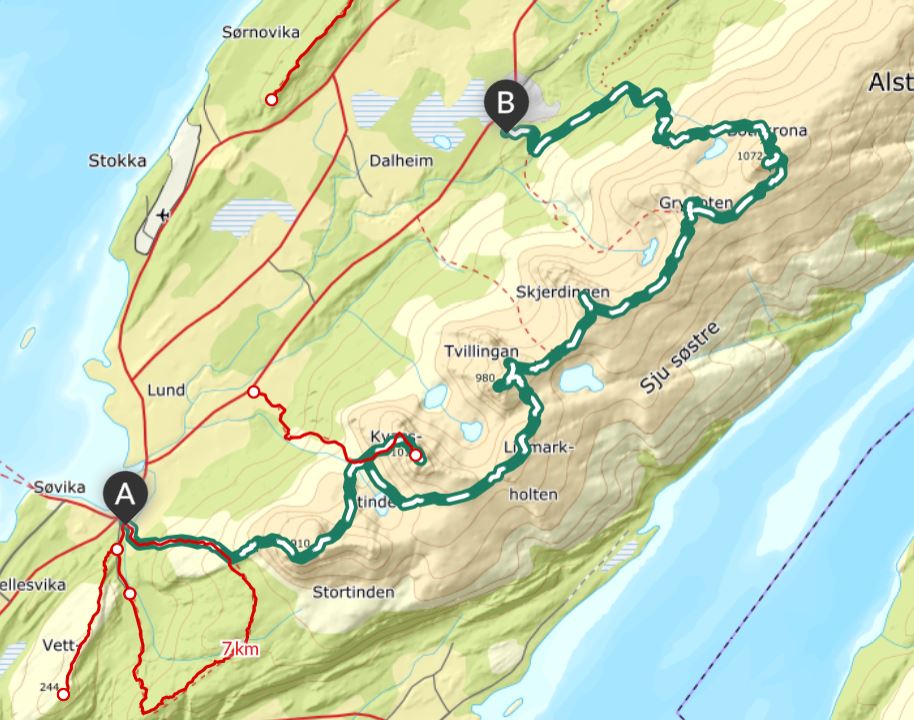 Ut.no / Norgeskart.no
Ut.no / Norgeskart.no
The Seven Sisters mountain range consists of seven peaks on the island of Alsta, near Sandnessjøen. Each peak stands around 1,000 metres and is demanding even on its own. To hike all seven in one day is a serious endurance challenge for experienced and fit hikers. The terrain is steep and rugged — your legs, knees, and ankles will be tested. Many people choose to end the hike partway and descend via the trails between the peaks.
This description follows the south-to-north route, which is recommended. The two southernmost peaks are the most demanding, so it’s best to tackle them while you’re still fresh. You’ll also have the sun at your back for most of the hike.
It is, of course, also possible to hike north to south, but be aware that this means saving the hardest peaks for last.
Peak 1 – Breitinden (910 m)
From the parking lot, you ascend to Breitinden, mostly over bedrock and large boulders. Follow the red trail markings up to the saddle, where the terrain levels off slightly. At the saddle, go left toward the summit (not straight ahead toward the “Storrunden” loop). The final climb to the summit is steep with large rocks.
Peak 2 – Kvasstinden (1,010 m)
From Breitinden, descend to the saddle and continue toward Kvasstinden. Snow may linger here well into the season, so follow the red trail markers. You may want to leave heavy gear at the bottom of this climb, as you’ll return the same way before continuing to peak 3. The ascent is steep and involves scrambling, with some exposed sections that may be uncomfortable for those afraid of heights. After summiting, return to the saddle. You can exit the hike here if needed.
Peak 3 – Southern Twin (980 m)
After descending from Kvasstinden, you’ve completed about half the total elevation gain. A long stretch begins toward the Twins, following red markers east around Kvasstinden. Fill your water bottles at one of the streams early in this section. The climb to the southern twin involves a steady incline and some light scrambling near the summit.
Peak 4 – Northern Twin (945 m)
Only 500 metres and 50 metres of elevation separate the two Twins. Descend the short steep section from the southern twin and climb directly up to the northern twin. Note: the true summit is where the summit box is — not the taller adjacent peak, which requires climbing skills and equipment. From here, you can exit the hike down to Markvollkulpen if needed.
Peak 5 – Skjerdingen (1,037 m)
Follow red markers north from the northern twin to the saddle (750 m) between Skjerdingen and the Twins. This is a good place to assess if you’re fit to continue. To exit, take the trail northwest to Markvollkulpen and the road. Otherwise, continue northeast up to Skjerdingen, where the terrain becomes rough and may require scrambling. Follow red trail markers to find the safest route.
Peak 6 – Grytfoten (1,019 m)
After summiting Skjerdingen, the journey continues toward peak 6, Grytfoten (1,019 m). Retrace your steps for about 50 metres before turning left (north) toward Grytfoten. The trail descends slightly to around 850 metres above sea level before the climb to the summit begins.
Just before reaching the top, there’s another opportunity to exit the hike and descend to the road if you choose to end your trip here. Remember — the most important thing isn’t reaching all the peaks, but making it back safely.
As you approach the summit of Grytfoten, the terrain becomes rough again and requires some scrambling, but the red trail markers will guide you along the best route to the top.
Peak 7 – Botnkrona (1,072 m)
When you reach Grytfoten, you’ll see the final and highest peak of the hike — Botnkrona (1,072 m). The trail continues with a short return along the path you came up. When the trail forks, take the left turn (northward) and follow the marked path down and along the eastern side of Grytfoten. Snow can remain here until August, but it’s usually not a problem as long as you follow the red trail markings.
The ascent to Botnkrona begins from the east side of the mountain. When the trail splits just before the summit, you may want to leave your heavy gear behind, since you’ll return the same way. The final climb is steep, but once you reach the summit, all the uphill sections are behind you — and you’re standing at the highest point on the entire Seven Sisters ridge.
However, the hike isn’t over yet. The descent from Botnkrona can feel like the toughest part of the entire trip. After a long day of climbing and descending, this last stretch takes you through a long, steep, and rugged terrain that can be difficult to navigate. This is the only section of the hike where ropes have been installed to assist hikers. Take your time — even if you’re eager to reach the bottom.
Once you reach Fjellsåsvannet, the most challenging part is over. From there, it’s a relatively easy stretch on a well-defined path back to the parking lot — and you’ve completed the Seven Sisters!
One thing to keep in mind is transportation between the starting and ending points. It’s best to arrange this in advance; otherwise, you’ll need to take a taxi or walk the 7 km back.
If you’d like to commemorate your achievement, you can order a certificate for completing the Seven Sisters from DNT Sandnessjøen by emailing: sandnessjøen@dnt.no. Price: NOK 150 per certificate.
View hike description on UT.no
View starting point on Google Maps
1. Follow the Norwegian Mountain Code and plan according to your ability and equipment
Short hikes on easy terrain don’t require much. If you’re heading out for an hour or two in the lowlands and not gaining much elevation, you won’t need a lot of gear or be in top shape. If it gets cold or you get tired, you’re usually not far from your car.
But if you’re heading into more challenging terrain—steeper, rougher, and above the treeline where the weather is more unpredictable—you’ll need to be better prepared. You should plan the trip based on weather and conditions, be fit enough to complete it, and be ready for uneven ground, boulder fields, slippery roots, and stream crossings. That means carrying a heavier pack with extra clothes and gear, and wearing sturdy hiking boots that support your ankles.
If you’re unsure about taking on a demanding mountain hike, start with an easy or moderate one and see how it feels.
Learn more about the Norwegian Mountain Code at rodekors.no
See what you should bring on your hike on VisitNorway.com
2. Stick to marked trails
A shortcut through unfamiliar terrain can easily turn into a long and difficult detour. What looks like a trail might just be a sheep path that leads you somewhere completely unexpected. If you want the hike to be as easy or challenging—and as long or short—as planned, it’s best to follow marked trails.
If you’re heading off-trail, it’s smart to follow a GPS track. You can download a GPX file from a hike description and use it on a GPS device, a smartphone app, or a GPS watch.
UT.no and the UT app offer hike descriptions with GPS tracks. If your hike doesn’t have one, you can upload a track to ut.no/mine-turer and access it in the app. It’s free, but you’ll need to create an account.
Always carry a map and compass as backup.
UT app for Android / UT app for iPhone
3. Talk to locals or join a guided hike
Locals often have useful tips about your planned hike. They can tell you where to park, whether there’s phone coverage, if the trail is wet, if rivers are high, or suggest a better alternative. Talk to the people where you’re staying, at the local tourist office, or other hikers on the trail—you might get some truly valuable advice.
The best option is to hike with a guide. You can join a group tour or book a private guide. These are experienced locals who know the area well. They’ll help tailor the hike to your needs and share insights that add to the experience.
4. Look out for cultural landmarks
Even high up in the mountains, you’ll find traces of past human activity—some hundreds or even thousands of years old. These can include ancient trail markers, signal cairns, hunting fences, huts, and shepherd shelters. If you spot something interesting, check the KulturPunkt app to see what it is—or use the app to find a cultural site as your hiking goal.
KulturPunkt app for Android / KulturPunkt app for iPhone
KulturPunkt.org
5. Remember your responsibilities under the Right to Roam
Norway’s Right to Roam means you can hike, bike, pick berries, camp, fish, and ski almost anywhere in nature. But it also comes with responsibilities—what we call the “duties of the Right to Roam.” Leave no trace, respect wildlife, and know the rules for hunting, fishing, cycling, and access in protected areas like national parks and nature reserves.
Read more about the Right to Roam and your responsibilities at VisitNorway.com
Thank you for respecting the local communities, and for helping us preserve the natural beauty of Helgeland!
Please:
- Strive to leave no trace of your visit. Bring back all your rubbish, including used toilet paper, and discard it in the nearest rubbish bin.
- Plan your toilet visits and use the opportunity when you pass a toilet. In the wilderness, make sure you are not a nuisance to others.
- Respect the local wildlife. Keep a good distance from wildlife, livestock and birds. Keep your dog leashed.
- Respect private property. Keep a respectful distance from houses and cabins.
- Show good boating sense. Keep a good distance from shore and drive at a low speed, especially when you are close to anyone or anything on the water, including birds or animals. Avoid loud and disturbing engine noise. Be aware that some islands and nature reserves are important nesting sites, and that going ashore is prohibited during the nesting season.
- Follow the Norwegian Mountain Code (Fjellvettreglene). Plan your excursion according to the weather forecast, your skills and experience.
- Join a guided excursion or consider hiring an experienced guide, especially when you don’t have sufficient experience or knowledge to guarantee a safe trip.
Find accommodation, food, and activities nearby.
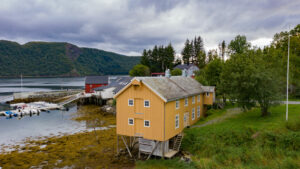
Bergh-brygga and Gammelskolen in Leirfjord
Leirfjord Museum is located in the old Bergh-brygga at Leland. Also, make sure to visit the beautiful Gammelskolen, which was in operation until the mid-1950s. Welcome to a journey through time!

Guided mountain tours on Dønna and the Seven Sisters
Join a guided mountain tour to three of the finest hiking destinations in Dønna and Sandnessjøen. Herøy Kayak & Bike can guide you on an easy hike to Åkvikfjellet or Markvollkulpen, or join us to the top of the spectacular mountain Dønnamannen.
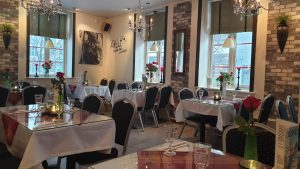
Restaurant Soprano – Wining and dining in Sandnessjøen
Restaurant Soprano offers a taste of Italy in rustic surroundings. During the summer, you can dine at an outdoor table, surrounded by trees, cobblestones and people strolling along the pleasant pedestrian street on which the cosy restaurant is situated.

Guided island hopping by bike to Dønna and Herøy.
Take a guided bike ride from Sandnessjøen to the scenic islands of Dønna and Herøy, with stops at charming cafés and unique local shops along the way.
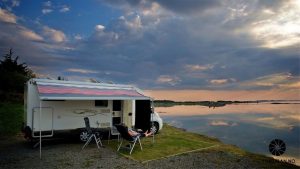
Sandnessjøen Camping
Sandnessjøen camping is located at Steiro along the Rv 17, 10 kilometers south of Sandnessjøen. Sandnessjøen Camping is just a short walk from the mountains De Syv Søstre and the local airport.
